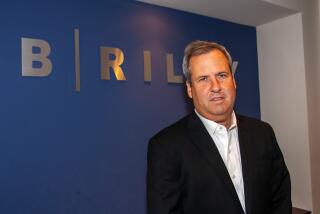Control of Assets Called Key to S&L; Bond Payoff
- Share via
PHOENIX — The roughly 22,000 investors who bought $200 million in bonds issued by the parent of Lincoln Savings & Loan Assn. are unlikely to recover their money unless regulators turn loose Lincoln’s assets, the parent’s chairman said Monday.
The fate of the bondholders, many of them elderly investors who sunk their life savings into the securities, “totally depends on whether or not we get back some of the operable assets” of Lincoln, said American Continental Corp.’s Charles H. Keating Jr. in an interview.
Phoenix-based American Continental filed for protection from creditors in U.S. Bankruptcy Court on April 13 when it realized that federal regulators were considering seizing Irvine-based Lincoln, its primary subsidiary.
The move was viewed as an effort to hold off the regulators, but federal officials succeeded in gaining control of Lincoln the next day. Regulators alleged that it was being operated in an “unsafe and unsound” manner by American Continental, although the S&L; was not declared insolvent. Lincoln was placed into a conservatorship.
Unsecured Creditors
The bankruptcy filing threw into doubt whether the 22,000 bondholders would ever see their money again. As unsecured creditors of American Continental, the bondholders would rank behind other creditors who are owed money by the company.
Hundreds of bondholders have joined in several class-action lawsuits filed against American Continental, Keating, other corporate officers and directors, and the lawyers and accountants who advised the holding company.
The plaintiffs claim that the company misrepresented the bonds, which were considered below investment grade and were not covered by the government’s deposit insurance program. Some said the salespeople who sold the bonds at Lincoln’s 29 branches in Southern California made it appear as if they were as secure as federally insured certificates of deposit.
Keating, a controversial businessman who has clashed frequently with regulators, has filed a lawsuit against federal regulators seeking to regain control over certain assets of several Lincoln subsidiaries. Those assets include the luxurious Phoenician Resort, the Crescent Hotel and the partly built Estrella planned community. The three Phoenix-area developments were funded by Lincoln.
Keating portrayed his litigation as the only real hope for bondholders. Lawsuits filed against him would be fruitless because all his money is tied up in American Continental and Lincoln, he said.
“We can win in the courtroom and recover some of our operating assets,” Keating said. “Then we go back in business, exploit them (the assets) as we would have in the normal course of business and ultimately pay off the bondholders.”
Risk Acknowledged
Keating acknowledged Monday that the bonds were risky, saying there was “some parallel to junk, or high-yield” bonds. But he insisted that the company did not misrepresent them and that the bonds were safe before the company’s bankruptcy filing.
Keating said he was so confident that American Continental could pay off the bonds that he would not have hesitated to recommend them to anyone, even his favorite Catholic charities. One of the largest creditors in American Continental’s bankruptcy is the Sisters of Charity organization in Cincinnati, which holds $444,000 in corporate bonds.
“We would have recommended the bonds to any buyer,” he said.
Keating said American Continental had not missed a payment on the bonds until it filed for bankruptcy protection last month.
“We did not then and do not now have any feeling that those bonds weren’t legitimate instruments issued to people who fully understood what they were getting,” he said. “We had every intention to make those good.
“If we didn’t recognize something, it was that the march of regulation would ultimately end up with the confiscation of our operating businesses,” he said. “We didn’t see that. I’m sure that can be short-sightedness on my part or hope springing eternal in the human breast, but we just didn’t see that. We probably should have.”
More to Read
Inside the business of entertainment
The Wide Shot brings you news, analysis and insights on everything from streaming wars to production — and what it all means for the future.
You may occasionally receive promotional content from the Los Angeles Times.










